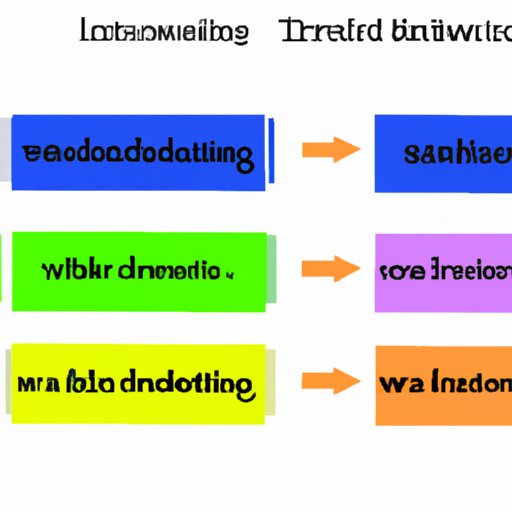Introduction
Transition is a key element in writing. It helps to create cohesion between ideas, paragraphs, and sections of writing, and it can bring clarity and focus to the reader’s understanding of a piece. But what does transition mean in writing?
Transition is defined as “the process or a period of changing from one state or condition to another” (Oxford Dictionary). In writing, it refers to the process of bridging one idea to the next. It is used to show the connection between two or more ideas and to help the reader to understand and follow the ideas presented in a piece of writing. This article will explore the role of transitions in writing, how they can be used to enhance writing, and the benefits that transitions offer to writers.
Analyzing the Role of Transitions in Writing
Transitions are essential to writing because they help readers to understand and follow the ideas presented in a piece. They are used to indicate relationships between ideas, such as similarities, contrasts, causes, effects, and sequences. For example, a writer might use the transition words “however” and “nevertheless” to show a contrast between two ideas, or the transition word “therefore” to indicate a cause-and-effect relationship.
Transitions are also used to signal shifts in time, place, and topic. For instance, a writer might use the transition phrase “in addition” to introduce a new point, or the transition phrase “meanwhile” to indicate a shift in time or place. By using transitions, a writer can make it easier for readers to understand and follow the ideas presented in a piece.
Exploring How Transitions Can Enhance Writing
Transitions can have a powerful effect on the tone, style, and flow of a piece of writing. When used effectively, transitions can help to create cohesion between paragraphs and ideas and to add emphasis to certain points. They can also help to keep the reader engaged by making the writing more interesting and dynamic.
In addition, transitions can help to create a sense of structure and organization in a piece of writing. By showing relationships between ideas, transitions can emphasize the main points and help the reader to follow the argument more easily. As a result, transitions can make a piece of writing more effective and persuasive.

Examining What Transitions Mean for Writers
The importance of transitions for a successful piece of writing cannot be overstated. Without transitions, a piece of writing can feel choppy and disjointed. On the other hand, by using transitions effectively, a writer can create a smooth, cohesive piece that is easy to read and understand.
For this reason, it is important for writers to understand how to incorporate transitions into their writing. Some strategies for doing so include using transitions at the beginning of each new paragraph, using transitions to connect ideas within each paragraph, and using transitions to link paragraphs together. By following these strategies, writers can ensure that their writing is clear, logical, and well-structured.
Understanding the Benefits of Writing with Transitions
Using transitions in writing can have many benefits. One of the most important is improved readability and comprehension. By using transitions, a writer can make it easier for readers to follow the ideas presented in a piece of writing. As a result, readers are more likely to understand and remember the content of the writing.
In addition, transitions can help to increase clarity and focus in a piece of writing. By connecting ideas and emphasizing main points, transitions can help to create a clear and understandable argument. As a result, readers are more likely to stay engaged and to take away the intended message of the writing.

Tips for Incorporating Transitions into Your Writing
When incorporating transitions into your writing, there are a few things to keep in mind. First, it is important to use the right types of transitions in the right places. For example, if you are trying to show a contrast between two ideas, it would be appropriate to use the transition words “however” or “nevertheless”. On the other hand, if you are trying to show a cause-and-effect relationship, it would be more appropriate to use the transition word “therefore”.
It is also important to know when to use transitions and how often. Too many transitions can make a piece of writing seem choppy and disorganized, while too few can make it difficult for readers to follow the ideas presented. As a general rule, transitions should be used sparingly, but often enough to show the connections between ideas.
Finally, it is important to use the right words when connecting ideas. The best transitions are those that accurately reflect the relationship between the ideas being connected. For example, if you are connecting two ideas that have similar implications, it would be more appropriate to use the transition word “similarly” rather than “however”.

Crafting Fluid Sentences with Transition Words
In addition to using transitions to connect ideas, it is also possible to use transition words to create smooth transitions between sentences. Transition words can be used to make the sentence structure more fluid, and to emphasize certain points. There are several different types of transition words, including conjunctive adverbs, prepositional phrases, and subordinating conjunctions.
When using transition words to create smooth transitions between sentences, it is important to combine them with other sentence elements. For example, a writer might use a transitional word such as “furthermore” to introduce a new point, and then combine it with an independent clause to create a complete sentence. By combining transition words with other sentence elements, a writer can create sentences that flow naturally and smoothly.
Conclusion
Transition is an important part of writing. It helps to create cohesion between ideas, paragraphs, and sections of writing, and it can bring clarity and focus to the reader’s understanding of a piece. By understanding the role of transitions in writing, how they can enhance writing, and the benefits that transitions offer to writers, writers can ensure that their writing is effective and persuasive.
This article has explored the role of transitions in writing, how they can be used to enhance writing, and the benefits that transitions offer to writers. It has also provided tips for incorporating transitions into writing and crafting fluid sentences with transition words. With this knowledge, writers can ensure that their writing is clear, logical, and well-structured.
For further reading, consider checking out The Little Book of Transitions: A Guide to Writing with Clarity and Style by Roberta H. Markham. This book offers practical advice on incorporating transitions into writing, as well as tips for creating smooth, cohesive sentences.
(Note: Is this article not meeting your expectations? Do you have knowledge or insights to share? Unlock new opportunities and expand your reach by joining our authors team. Click Registration to join us and share your expertise with our readers.)
